IGBC CLARIFIES BEAR SPRAY RECOMMENDATIONS
A victory for the safety of people in bear country recently occurred when the Interagency Grizzly Bear Committee (IGBC) took unanimous action to clarify its bear spray recommendations. Comprised of representatives of various state, federal, and Canadian wildlife management agencies, the IGBC helps coordinate the recovery of grizzly bear populations, and provides public information about bear safety and the use of bear spray. The IGBC has historically recommended that bear sprays have a minimum duration of six seconds. Recently, however, the IGBC adopted a new policy that recommends the use of any EPA-registered bear spray product without reference to spray duration, that is, the time it takes for a can to discharge completely. The IGBC correctly recognized that existing federal bear spray registration standards are adequate for public safety and that consumers should follow the manufacturer’s instructions for proper use of their selected bear spray product. Exercising its collective professional judgment, the IGBC appropriately withdrew its outdated six-second spray duration recommendation, which lacked any scientific or empirical justification, and conflicted with modern bear spray studies.
Following the IGBC’s decision, UDAP has received various inquiries about the meaning of and reasons for the IGBC’s action. Many of these questions appear to have arisen from a misunderstanding of how bear spray is regulated, how it is intended to be used, and from incorrect or incomplete reports in the media. The following Question and Answer narrative is intended to provide clarity for those who have reasonably been left confused by recent media coverage. Customer safety is UDAP’s number one priority, and we feel an obligation to provide clear, accurate, and complete information to our customers. If you have questions or need further information, please do not hesitate to contact UDAP’s leadership here, or visit UDAP’s website. We would be delighted to hear from you.
Who regulates bear spray?
Bear spray is considered a pesticide and is regulated by the U.S. Environmental Protection Agency (EPA) pursuant to broad authority granted under the Federal Insecticide, Fungicide, and Rodenticide Act (FIFRA). FIFRA establishes that all pesticides sold or distributed in the United States must be registered by the EPA. Registration is based on evaluation of scientific data, product performance testing, and assessment of the risks and benefits of a product’s use. Currently, there are only four EPA-registered bear spray products on the market. The EPA also regulates pesticide labels and instructions, which allows the agency to control how products are used. It is unlawful for any person to use a registered pesticide product, such as bear spray, in a manner inconsistent with its labeling.
What role does the IGBC have regarding bear spray?
Unlike the EPA, the IGBC does not have statutory authority to regulate bear spray, or its registration, labeling, or use. Instead, the IGBC’s mission is to “Recover, manage, and secure the future of grizzly bear populations and their habitat so that grizzly bears no longer require protections afforded by the [Endangered Species Act].” The use of bear spray is an important management tool that serves the IGBC’s mission by helping promote the recovery and survival of the grizzly bear as a species. Bear spray is a powerful, non-lethal deterrent that, when used correctly, can stop a bear attack or lessen its severity without permanently harming the animal. It is an effective alternative to lethal personal protection options, such as firearms, and its use can both reduce human injuries caused by bears and decrease the number of bears killed in self-defense. For these reasons, the IGBC recommends bear spray when used in conjunction with proper bear avoidance safety techniques, and has historically provided the public with guidelines for selecting an adequate bear spray product.
What was the IGBC’s recent action?
The IGBC recently revised and clarified how it will provide the public with information and recommendations about selecting bear spray. During the infancy of commercial bear spray development in the 1990s, the IGBC established a set of bear spray guidelines that included such things as recommended spray distance and pattern, concentration of active ingredient, minimum net weight, and minimum spray duration. For years, the IGBC recommended the use of bear spray with a minimum spray duration of six seconds.
On December 13, 2016, the IGBC Executive Committee unanimously withdrew the six-second duration guideline in favor of recommending the use of any EPA-registered bear spray product, without regard to a numeric bear spray duration criterion. The IGBC recognized that EPA’s current bear spray registration standards are adequate, and it committed to rewriting its bear spray guidelines so that public has the most accurate and reliable information available. The IGBC will publish its revised bear spray recommendations by the end of February 2017.
Please note that the IGBC’s action does not, in any way, allow for the production of small, palm-sized pepper sprays to be marketed as “bear spray.” EPA’s pesticide registration requirements prevent this from occurring.
What led to the IGBC’s clarification of its bear spray recommendations?
The exercise of sound professional judgment and scientific reasoning is what most directly led to the IGBC’s revision of its bear spray recommendations. UDAP played a supporting role by providing information and initiating discussion and review of the six-second spray duration guideline. In June 2016, the IGBC invited UDAP to make a presentation to the Executive Committee at its summer meeting in Bonners Ferry, Idaho. At the public meeting, UDAP highlighted the lack of scientific or empirical support for the six-second spray duration guideline and explained how the recommendation served no purpose other than to improperly promote or endorse one particular commercial bear spray manufacturer over all others. After its presentation, UDAP requested the following two actions:
- That the IGBC withdraw the six-second spray duration recommendation and reconsider the committee’s role in issuing public position statements on bear spray product performance and efficacy; and
- That the IGBC fulfill its promise not to promote or endorse one commercial bear spray product over any other.
The IGBC agreed to consider UDAP’s requests and formed a bear spray work group to evaluate its bear spray recommendations and appearance of implied product endorsement. At the IGBC’s winter meeting on December 13, the work group reported its findings to the Executive Committee and recommended taking action consistent with UDAP’s request. Upon the work group’s recommendation, the IGBC unanimously agreed to continue to recommend use of EPA-registered bear spray products and to rewrite its bear spray recommendations/guidelines without reference to a numerical spray duration criterion. The IGBC also agreed to continue to be vigilant and conscious not to promote or endorse any one commercial bear spray product over another, and decided to add an additional disclaimer to its website.
The IGBC’s actions are good for public safety and government transparency. In revising its bear spray recommendations, the IGBC has embraced science and sound professional judgment, and demonstrated a commitment to providing the public with accurate, reliable, and meaningful information about bear spray.
Did UDAP file “legal action” against the IGBC?
No, contrary to erroneous media reports, UDAP has not filed legal action against the IGBC in any court or administrative body. UDAP presented its concerns in an open public forum at the IGBC’s regularly scheduled summer meeting. UDAP submitted written materials and a PowerPoint presentation for the IGBC’s review and consideration, and engaged the IGBC in a professional, courteous, and productive manner, without any need for litigation.
What were UDAP’s main concerns in bringing this issue to the IGBC?
UDAP’s main concerns were: (1) public safety, (2) the need for accurate public information about bear spray, and (3) the basic notion that bear spray recommendations ought to be grounded in sound science, not speculative opinion.
UDAP’s core mission is to provide for the safety of people who are hunting, fishing, and recreating in bear country, and its products are specifically designed to fulfill that purpose. As a company that stakes its reputation on keeping people safe and alive in bear country, UDAP was concerned that the IGBC’s six-second bear spray guideline was not based on science or empirical data, and yet it was being represented to the public as a benchmark for product safety and performance. In truth, there is no scientific literature or peer-reviewed research concluding that bear spray with a six-second spray time is any safer or more effective than bear spray with a four- or five-second spray time, when used properly. Indeed, the leading contemporary bear spray researcher, Dr. Tom S. Smith, has concluded that “based on data we collected, there is no indication that any of the commercially available products bests another by durations that vary by a few seconds,” but instead “all fall within an acceptable range of effectiveness in light of the results of the study I conducted on the efficacy of bear spray in Alaska.”
Consistent with Dr. Smith’s observations, EPA-registered bear spray products have proven to be effective, non-lethal tools for deterring bear attacks, and there is no evidence that any EPA-registered bear spray product is unsafe or inadequate for its intended purpose, even though a majority of bear sprays do not meet the old six-second guideline. There is an obvious disconnect between the six-second guideline and the actual performance and efficacy of bear spray in the field, and as long as the six-second guideline remained in circulation, the public was not receiving the most accurate and reliable information in selecting bear spray. UDAP – with the support of another bear spray producer, scientists, experts in human-bear interactions, and users of bear spray – contacted the IGBC to voice its concerns and set the record straight on the six-second rule.
Upon review of UDAP’s presentation, written submissions, and its own independent research, the IGBC unanimously decided to remove the duration guideline from its public recommendations. It is anticipated that the IGBC will publish its revised bear spray recommendations and white paper by the end of February 2017.
UDAP supports the IGBC’s decision, and applauds the Executive Committee’s efforts to provide the public with accurate information concerning bear spray and its use. The IGBC members showed leadership and interest in public safety by basing its decision on available science and proven experience, rather than the speculative opinions of those advocating for an arbitrary six-second rule. Those living, working, and recreating in bear country are safer today and will gain more confidence in the use of bear spray due to the actions of the IGBC and its clarified recommendations. Removal of the six-second rule will also eliminate favoritism, alleviate concerns about implied government endorsement of commercial products, and contribute to better public education concerning bear spray. Those looking to purchase bear spray should seek out an EPA-registered bear spray product and follow the manufacturer’s instructions printed on the label for its proper use.
If you wish to learn more about the underlying fallacies of the six-second guideline, please see UDAP’s written submissions to the IGBC, here and here, and its PowerPoint presentation, here.
Where did the erroneous “six-second” recommendation come from?
The origin of the six-second spray duration recommendation is shrouded in uncertainty. What is known is that in the late 1990s, when commercial bear spray use and development was in its relative infancy, the IGBC tasked the Yellowstone Ecosystem Subcommittee (YES) to issue a bear spray position statement to inform and educate the public about the use of bear spray for self-defense in the backcountry. The YES committee recommended bear spray with a range of 25 feet and use of the “largest size” can available, to accommodate things like environmental conditions (wind, rain, cold), highly agitated bears, multiple bear encounters, multiple charge encounters, and having reserve spray for the hike out.
The IGBC subsequently outsourced its review of bear spray to the Center for Wildlife Information (CWI), a now defunct non-profit organization which was led by an individual without any formal scientific training and who is believed to have had a close association with the only bear spray company (at the time) to produce a can that sprayed for longer than six seconds. In 1999, CWI presented its bear spray recommendations and urged the IGBC to adopt a six-second spray duration guideline, which it did. It was at this time that the YES committee’s original recommendation to use the “largest size” can available was transformed into a numeric duration recommendation.
While the six-second duration recommendation has persisted for years, the underlying basis and justification for the guideline has never been substantiated with scientific or empirical data, despite repeated inquiries and a formal request under the Freedom of Information Act, 5 U.S.C. § 552, for documents, studies, reports, and any other supporting information. The lack of any supporting documentation calls into question the transparency and neutrality of the process, reasoning, and justification for the six-second rule.
Promoters of the duration guideline continue to refer to the research of Dr. Charles Jonkel and Carrie Hunt from the 1970s and 1980s to support their position. While the importance of Dr. Jonkel’s and Ms. Hunt’s research to the development of bear spray as an effective deterrent cannot be overstated, their work simply does not conclude or provide direct support for any numeric duration guideline, let alone a six-second requirement. At most, Ms. Hunt’s research suggests the need for bear spray that has “repeated application,” which all EPA-registered bear sprays are capable of doing. Moreover, Dr. Jonkel’s and Ms. Hunt’s research predates the EPA’s regulation and oversight of bear spray, and so they lacked any opportunity to test the performance and efficacy of the products now on the market, which significantly limits the relevance of their research to the question of duration.
Another misperception commonly held by proponents of the six-second rule is that six seconds is needed to compensate for various contingencies, such as repeated attacks, multiple bear scenarios, weather, and the hike out. These scenarios do not, however, lend themselves to a quantifiable duration standard and they fail to establish why six seconds is the “magic” number to accommodate all these situations, as opposed to some other number. What these scenarios do suggest is the need for a bear spray capable of deploying repeated bear-stopping bursts. As the IGBC’s own bear spray testing shows, even a 7.9 oz can with a four-second discharge time is more than capable of accommodating these various scenarios, assuming it is deployed properly (i.e., using one-second bursts, as per manufacturer instructions). Moreover, these scenarios can be accommodated in other ways, such as recommending use of the largest volume canister of spray, as the YES committee suggested, or by carrying multiple cans of bear spray.
If not duration, what is important when choosing a bear spray product?
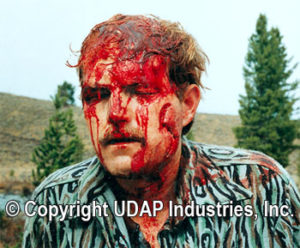 As a grizzly bear attack survivor, Mark Matheny – the founder and president of UDAP – encourages the use of a high-volume spray. Published studies demonstrate that in many bear encounters an individual has less than two seconds to react before the bear makes contact. In these situations, it is not a matter of how long the can sprays in a constant duration, it is a matter of how quickly the product can deliver a bear-stopping dose of spray. Bear spray is specifically designed to be deployed in repeated bursts, and UDAP bear spray, in particular, is designed to deliver a powerful, high-volume spray with each burst, when it’s needed most. Given bear spray canisters with equal potency and spray characteristics, other than duration, would you rather have the spray that comes out slower (longer duration/lower volume) or the one that comes out faster (shorter duration/higher volume) if a grizzly bear is charging at you?
As a grizzly bear attack survivor, Mark Matheny – the founder and president of UDAP – encourages the use of a high-volume spray. Published studies demonstrate that in many bear encounters an individual has less than two seconds to react before the bear makes contact. In these situations, it is not a matter of how long the can sprays in a constant duration, it is a matter of how quickly the product can deliver a bear-stopping dose of spray. Bear spray is specifically designed to be deployed in repeated bursts, and UDAP bear spray, in particular, is designed to deliver a powerful, high-volume spray with each burst, when it’s needed most. Given bear spray canisters with equal potency and spray characteristics, other than duration, would you rather have the spray that comes out slower (longer duration/lower volume) or the one that comes out faster (shorter duration/higher volume) if a grizzly bear is charging at you?
In addition to having a high volume, bear spray should be registered by the EPA and be clearly labeled for use on bears. It should spray in an expanding fog pattern with sufficient distance to intercept a charging bear, and it should contain the highest concentration of capsaicin and related capsaicinoids regulated by EPA (currently, 2.0%). The net weight of bear spray should be at least 225 grams or 7.9 ounces, as required by the EPA, and it should be capable of providing repeated bursts of spray.
While the above considerations are important for selecting a bear spray product, it is even more critical for the user to be familiar with the specific performance characteristics of their chosen product and to understand and follow the manufacturer’s instructions for its use . . . and to practice.
I have seen numerous instructions for the proper use of bear spray, but they are not always consistent. Which one should I follow?
You should follow the manufacturer’s instructions printed on the label of your chosen bear spray product. Bear spray is regulated by the EPA and federal law requires users and consumers of bear spray to deploy the product in a manner consistent with instructions on the label.
Unfortunately, there is an ever-increasing amount of conflicting information about the proper use of bear spray being produced in media reports, government websites and publications, and by special interest groups. While the intent of these sources is to educate the public on how to effectively use bear spray, the unintended consequence has been consumer confusion and misunderstanding. It is critically important to recognize that not all bear spray products perform in exactly the same manner, and the variability in performance characteristics across product lines makes it exceedingly difficult and counterproductive to develop a set of generic bear spray recommendations to apply across the board.
For example, some sources instruct users to “spray for 2-3 seconds” when the bear is approaching. This instruction ignores the fact that not all bear sprays discharge the same amount of active ingredient per unit of time. For instance, a one-second high-volume burst from a UDAP can may discharge the equivalent amount of active ingredient as a two- or three-second burst from another brand of bear spray. UDAP’s EPA-approved instructions direct users to release a one-second burst of spray as an attacking bear is charging. To instruct a UDAP user to unnecessarily deplete his or her canister with a two- to three-second spray is not only irresponsible and dangerous, it also encourages use of the spray in a manner inconsistent with its label.
Other sources instruct the use of a zig-zag pattern or a side-to-side movement while spraying. This action is completely unnecessary for UDAP products, which have a broad spray pattern and are designed to billow outward in an expanding fog. Using a side-to-side motion while spraying not only wastes bear spray product, it decreases the effective distance the spray will travel, as can be seen in this video.
Bear spray producers continually test their products and develop specific, EPA-approved instructions for how to most effectively deploy the spray given the canister’s specific performance characteristics. Users should understand and follow the instructions printed on the label of their chosen bear spray product.
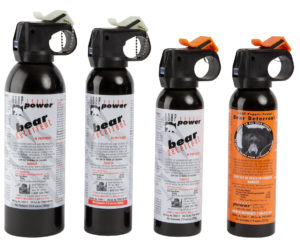
Please, tell me more about UDAP.
There are more people than ever recreating, hunting, fishing, and enjoying the wild lands of North America and elsewhere around the globe. In many cases, they are doing so in the midst of prime grizzly/brown and black bear habitat, which has led to more conflicts among humans and bears than ever before. With bear populations on the rise, the need for a reliable and effective bear deterrent is as important as ever.
At UDAP Industries, we provide our customers with bear spray and personal protection products that help keep people safe in bear country. Our bear spray products are powerful and robust, with several sizes, including the largest can of bear spray on the market. Our customers tell us that the power and reliability of our products is the reason that UDAP bear spray is one of the most trusted and relied upon bear spray products available in the marketplace.
UDAP produces three sizes of bear spray:
- UDAP 7.9 oz. Bear Spray (sprays for approximately 4 seconds continuously)
- UDAP 9.2 oz. Bear Spray (sprays for approximately 5.4 seconds continuously)
- UDAP 13.4 oz. Bear Spray (sprays for approximately 7 seconds continuously)
Be prepared, carry bear spray, read the label, and know how to use it. Practice makes perfect sense.
For more information and bear safety tips visit www.BearSpray.com.
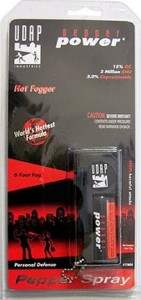
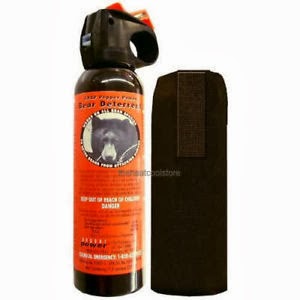
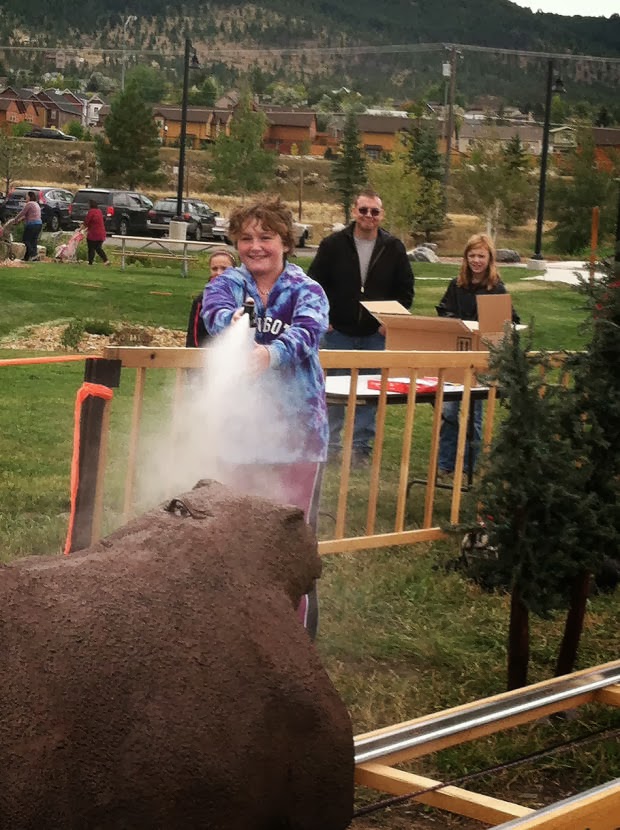
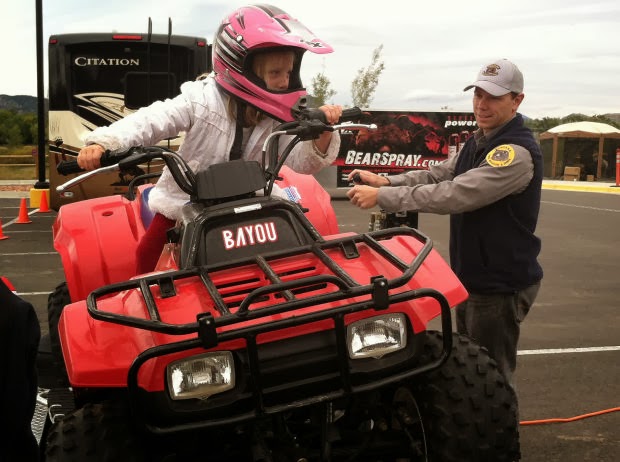

Shortly after Tim Lynch told his Bozeman boss about his interest in moving home to Butte, the company and Lynch’s family soon had a new mailing address.
Since late in 2008, Universal Defense Alternative Products Inc. has operated from a new facility just off Harrison Avenue.
Lynch, a Butte native, serves as general manager of the bear spray company’s 4,000-square-foot Butte operation.
“We are doing very well and we are growing at a very fast pace,” Lynch said. “We had a great year.”
The company formed in 1994, two years after a grizzly bear attacked owner Mark Matheny while bow hunting in Gallatin County.
To read the full article click here.